
| . |
HomePort  |
|
Family from Forfar
2.1
|
| . |
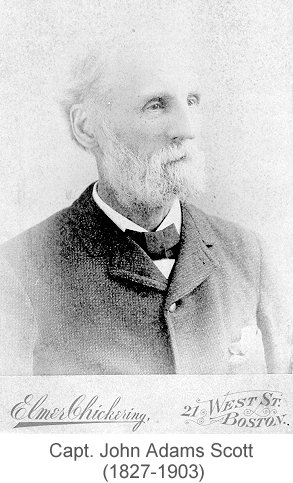 building trade. His
initial work within that industry was blacksmithing. He would own
his own shop as would his brother Daniel DeWolf Scott (1842-1919).
His father worked at various trades within the same industry and
it appears from later census records that his particular skill was
as a carriage painter. The story comes from a biographical sketch:
building trade. His
initial work within that industry was blacksmithing. He would own
his own shop as would his brother Daniel DeWolf Scott (1842-1919).
His father worked at various trades within the same industry and
it appears from later census records that his particular skill was
as a carriage painter. The story comes from a biographical sketch:“John Adams Scott of John A. Scott
& Son carriage builders, Boston, is a native of Nova
Scotia; born in Windsor, Hants County, October 20, 1827; son
of John and Elizabeth Dill Scott. His father was a native of
Halifax and his mother of Windsor, and his grandparents on
both sides were of Edinburgh, Scotland. He was reared on farms
and educated for the most part in the district school. His
mother dying when he was eight years old and the family being
broken up, he lived till his fifteenth year on the farm of his
father's only sister, attending school during the winter
months and upon her death he went to work upon another farm
employing his earnings for two years to the cost of finishing
his education. In April, 1846, he came to Boston working his
passage on a sailing vessel and apprenticed himself to Aaron
E. Whittemore of Roxbury, whose shop was on the corner of
Warren and Dudley Street where the Hotel Dartmouth now stands,
to learn the carriage smith's trade and spring making. Here he
remained for two years employing his evenings in the study of
book keeping, arithmetic and writing. His employer failing in
business he spent the next two years working as a journeyman
in Roxbury and Dorchester. Then in October 1851, he entered
business for himself in the same shop in which he learned his
trade and he has continued on the same street and near the
site of the old shop ever since. His works have been
repeatedly enlarged and he has for some time been a leading
member of the trade. He was president of the National Carriage
Builders Association in 1891, and is now (1894) president of
the National Carriage Exchange... He was married September 17,
1848, to Miss Sarah Sargent Long of Chester, N.H. They have
had three daughters and two sons; Mary Elizabeth, Mildred Orn,
Jessie Fremont, John Franklin and William Jackson Scott. The
eldest daughter Mary died in September 1874, and Mrs. Scott
died December 24 1889.”
-- from Richard Herndon & Edward Bacon’s "Men of progress: one thousand biographical sketches and portraits of leaders in business and professional life, Commonwealth of Massachusetts," published in 1896:
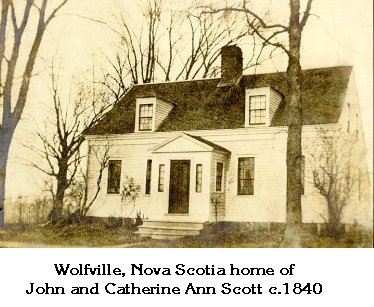 otia.
Documented within a ship's passenger list that suggests they were
accompanied by Andrew D. DeWolf a 40 year old merchant and 10 year
old Henry DeWolf (possibly relatives of Catharine Ann) who are
listed on the passenger list along with the two boys - Daniel
DeWolf Scott and Thomas Albert Scott (1840-1911).
otia.
Documented within a ship's passenger list that suggests they were
accompanied by Andrew D. DeWolf a 40 year old merchant and 10 year
old Henry DeWolf (possibly relatives of Catharine Ann) who are
listed on the passenger list along with the two boys - Daniel
DeWolf Scott and Thomas Albert Scott (1840-1911). 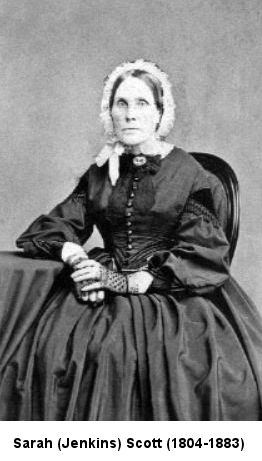 It came as a surprise when we located records which indicate that after the death of
Jean (Dalgity) Scott in 1851 that her son John Sr. married a third
time. In 1853 he married Sarah Jenkins (1804-1883) a widow who had
nine children and had lost her 50 year old husband on the 10th of
February 1852. In the decades that followed, Sarah and John Scott
Sr. are recorded as a married couple living with children until
the children left home. One of those children appears to have
followed John Sr. into the carriage painting trade. Each of the
census records covering their marriage show them together and some
record him as being born in England (which is correct) and other
census takers record Nova Scotia, we know from other researchers
that census records which rely on the skills of a variety of
people with minimal experience often depend on finding someone at
home who will then answer for the whole family. It is quite
possible that when John himself would answer he would state
England yet others who knew he was from Nova Scotia may have
assumed that he was born there rather than having arrived as a
toddler aged one. It is also possible he considered himself a Nova
Scotian who just happened to be born to Scottish parent in England
while his family was stationed at the Royal Artillery base in
Woolwich. The continued presence of the Curtis children in each
census record confirms that this is the same family headed by
Sarah and John Scott Sr. The fact that John Scott Sr. is listed
alternately as English-born and a Nova Scotia native can also be
seen as added confirmation that this is the same individual since
both areas had been part of his past. Roxbury and a life with
Sarah was now his future.
It came as a surprise when we located records which indicate that after the death of
Jean (Dalgity) Scott in 1851 that her son John Sr. married a third
time. In 1853 he married Sarah Jenkins (1804-1883) a widow who had
nine children and had lost her 50 year old husband on the 10th of
February 1852. In the decades that followed, Sarah and John Scott
Sr. are recorded as a married couple living with children until
the children left home. One of those children appears to have
followed John Sr. into the carriage painting trade. Each of the
census records covering their marriage show them together and some
record him as being born in England (which is correct) and other
census takers record Nova Scotia, we know from other researchers
that census records which rely on the skills of a variety of
people with minimal experience often depend on finding someone at
home who will then answer for the whole family. It is quite
possible that when John himself would answer he would state
England yet others who knew he was from Nova Scotia may have
assumed that he was born there rather than having arrived as a
toddler aged one. It is also possible he considered himself a Nova
Scotian who just happened to be born to Scottish parent in England
while his family was stationed at the Royal Artillery base in
Woolwich. The continued presence of the Curtis children in each
census record confirms that this is the same family headed by
Sarah and John Scott Sr. The fact that John Scott Sr. is listed
alternately as English-born and a Nova Scotia native can also be
seen as added confirmation that this is the same individual since
both areas had been part of his past. Roxbury and a life with
Sarah was now his future. 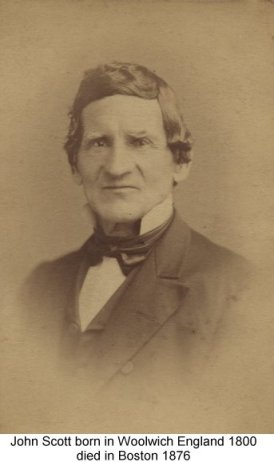 was single, married or widowed. He was clearly
marked as married. This fact did not match what we knew about the
widower but this had never been an issue until I was presented
with the marriage record of an individual named John Scott
recorded as being married for the third time to Sarah Jenkins. The
names of his parents and his birth place were all consistent with
what we know about John. At first this news came as a major
surprise and initial disbelief that the John Scott named in the
record was the same individual. I questioned the researcher for
more details and in examining those details as well as census
records for the period concluded that his death certificate was
accurate and that he was a married man at the time of his death
and not a widower. Census records
confirmed that he was residing with Sarah by 1855 and that his
sons were living together in the household of their older, married
brother. We were also able to confirm that the death certificate
which indicated he was married is the correct death record as it
matches his gravestone where he is buried within a family plot
along with his Scott relatives (children, their spouses and his
grandchildren) at Forest Hills Cemetery in Jamaica Plain. From
these records we learn that the third marriage to Sarah Jenkins was the longest marriage of his
life at 23 years. His first marriage had lasted 12 years and the
second only 6 years, prior to being widowed.
was single, married or widowed. He was clearly
marked as married. This fact did not match what we knew about the
widower but this had never been an issue until I was presented
with the marriage record of an individual named John Scott
recorded as being married for the third time to Sarah Jenkins. The
names of his parents and his birth place were all consistent with
what we know about John. At first this news came as a major
surprise and initial disbelief that the John Scott named in the
record was the same individual. I questioned the researcher for
more details and in examining those details as well as census
records for the period concluded that his death certificate was
accurate and that he was a married man at the time of his death
and not a widower. Census records
confirmed that he was residing with Sarah by 1855 and that his
sons were living together in the household of their older, married
brother. We were also able to confirm that the death certificate
which indicated he was married is the correct death record as it
matches his gravestone where he is buried within a family plot
along with his Scott relatives (children, their spouses and his
grandchildren) at Forest Hills Cemetery in Jamaica Plain. From
these records we learn that the third marriage to Sarah Jenkins was the longest marriage of his
life at 23 years. His first marriage had lasted 12 years and the
second only 6 years, prior to being widowed.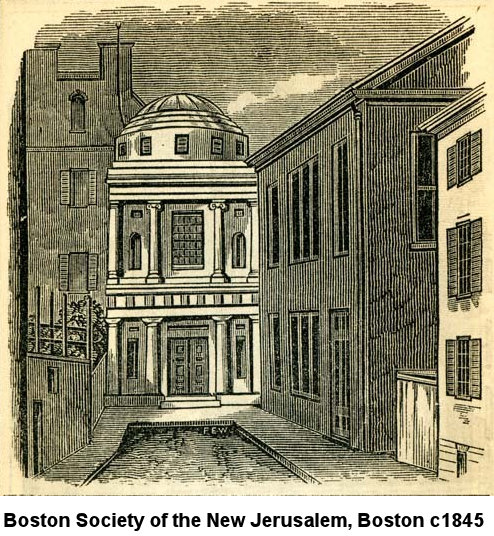 We learn from their
marriage certificate that their wedding took place at a New
Jerusalem Society church conducted by Pastor Thomas Worchester.
The New Jerusalem Society became established in Boston with
12 members in 1818, inspired by the writings of the Swedish noble and
scientist Emanuel Swedenborg, who wrote of his vivid mystical
experiences in great detail and published works of theology
divergent with official Lutheran doctrine of his era. Despite
the resulting challenges he faced
Swedenborg's work attracted the attention of many and followers
formed societies which eventually became churches to carry on his
work. A directory from 1843 indicates that Thomas Worchester
served a congregation of 236 in Boston and that the Society met in
the hall in Phillips Place. The New Church is the term currently associated with the Swedenborgian denomination;
which still remains a small denomination (just 100 congregations
in the US), and continues to innovate with new technology in
sharing the published works of Swedenborg as well as connecting
members and seekers without access to a local group.
We learn from their
marriage certificate that their wedding took place at a New
Jerusalem Society church conducted by Pastor Thomas Worchester.
The New Jerusalem Society became established in Boston with
12 members in 1818, inspired by the writings of the Swedish noble and
scientist Emanuel Swedenborg, who wrote of his vivid mystical
experiences in great detail and published works of theology
divergent with official Lutheran doctrine of his era. Despite
the resulting challenges he faced
Swedenborg's work attracted the attention of many and followers
formed societies which eventually became churches to carry on his
work. A directory from 1843 indicates that Thomas Worchester
served a congregation of 236 in Boston and that the Society met in
the hall in Phillips Place. The New Church is the term currently associated with the Swedenborgian denomination;
which still remains a small denomination (just 100 congregations
in the US), and continues to innovate with new technology in
sharing the published works of Swedenborg as well as connecting
members and seekers without access to a local group. 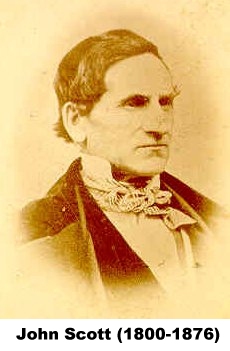 marriages and a total of 29 great-grandchildren
born. This generation also faced challenges with things like
tuberculosis and among the individuals
which survived there were 17 marriages. Over the next three
generations the family slowly began to grow with 36 babies born to the
fifth generation, 60 to the sixth generation and 89 to the seventh generation, to date. Those 89
individuals are all great-great-great-great grandchildren of John
Scott Sr. and includes the generation of the author's grandchildren.
As the connection of John Scott Sr. to his step-children and their
descendants was just discovered in early 2018 it will take further
research into this side of the family through his third marriage
to Sarah (Jenkins) Scott to better describe their history. An
early look at four of Sarah's nine children indicate that they had
families of 2, 3, 6, and twelve for a total of 23 grandchildren.
marriages and a total of 29 great-grandchildren
born. This generation also faced challenges with things like
tuberculosis and among the individuals
which survived there were 17 marriages. Over the next three
generations the family slowly began to grow with 36 babies born to the
fifth generation, 60 to the sixth generation and 89 to the seventh generation, to date. Those 89
individuals are all great-great-great-great grandchildren of John
Scott Sr. and includes the generation of the author's grandchildren.
As the connection of John Scott Sr. to his step-children and their
descendants was just discovered in early 2018 it will take further
research into this side of the family through his third marriage
to Sarah (Jenkins) Scott to better describe their history. An
early look at four of Sarah's nine children indicate that they had
families of 2, 3, 6, and twelve for a total of 23 grandchildren.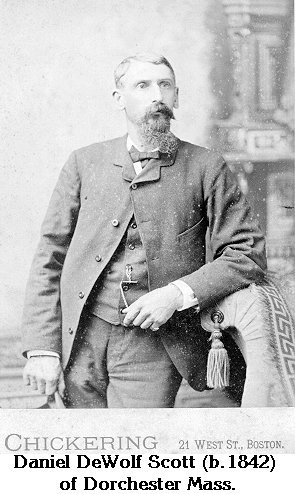 In 1861 a 19 year old Daniel
D. Scott found himself caught up in the machinery of war as an
enlisted member of the 32nd Regiment Mass Volunteer Infantry
during the Civil War. Like his older half-brother Capt. John
Adams Scott and is brother-in-law Sylvester Danforth Waugh, he chose to join
the war effort. Brother John was recognized for his role in
organizing Company F 4th Massachusetts Cavalry Regiment and
rising from Private to Captain. Young Daniel like many Civil
War enlistees faced a change-of-heart, or possibly like many
who left the US during the Vietnam War felt it was a matter
of conscience to avoid killing others, and turned his eyes
north to Canada. Officially he was a deserter and that
constituted a capital offence which was punishable by death.
Yet both sides in the Civil War faced unusually high rates
of desertion especially as the war ground on. The Union
Provost Marshal General estimated that nearly a quarter of a
million men had been absent from their units sometime during
the war. The Confederacy especially at the end faced equally
high desertion rates as word of the advancing opponents
reached soldiers from family members. While many deserted,
some did return and were accepted back. For Daniel, separated
from his family in Boston, that return would take
him a decade. Daniel married
at the age of 21 in Canada, and would return
with his family to Boston and the carriage
building trade a decade later in 1872 when he
moves his young family from Nova Scotia to
Boston.
In 1861 a 19 year old Daniel
D. Scott found himself caught up in the machinery of war as an
enlisted member of the 32nd Regiment Mass Volunteer Infantry
during the Civil War. Like his older half-brother Capt. John
Adams Scott and is brother-in-law Sylvester Danforth Waugh, he chose to join
the war effort. Brother John was recognized for his role in
organizing Company F 4th Massachusetts Cavalry Regiment and
rising from Private to Captain. Young Daniel like many Civil
War enlistees faced a change-of-heart, or possibly like many
who left the US during the Vietnam War felt it was a matter
of conscience to avoid killing others, and turned his eyes
north to Canada. Officially he was a deserter and that
constituted a capital offence which was punishable by death.
Yet both sides in the Civil War faced unusually high rates
of desertion especially as the war ground on. The Union
Provost Marshal General estimated that nearly a quarter of a
million men had been absent from their units sometime during
the war. The Confederacy especially at the end faced equally
high desertion rates as word of the advancing opponents
reached soldiers from family members. While many deserted,
some did return and were accepted back. For Daniel, separated
from his family in Boston, that return would take
him a decade. Daniel married
at the age of 21 in Canada, and would return
with his family to Boston and the carriage
building trade a decade later in 1872 when he
moves his young family from Nova Scotia to
Boston.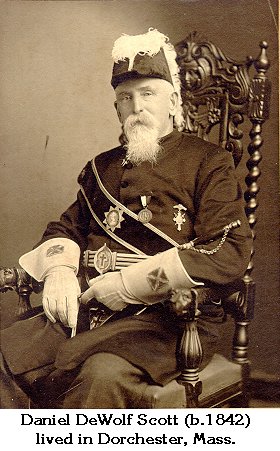 We know that it was in 1850 that Daniel DeWolf
Scott at age eight travelled with his brother Thomas
Albert Scott (age 10 ) from Wolfville to
Boston on the schooner Albatross. It is likely
that Andrew D. DeWolf a 40 year old merchant and 10 year
old Henry DeWolf, listed as well were relatives of their
deceased mother, Catharine Ann DeWolf, and possibly they
were ensuring the Scott boys travelled safely from
Wolfville Harbour to their destination in Boston where
they would meet their father
and their Scott relatives. If this theory is
correct then the older generation had gone ahead and final
move in 1850 likely consolidated the family once again
after the initial migration which had begun south in 1846.
We know that it was in 1850 that Daniel DeWolf
Scott at age eight travelled with his brother Thomas
Albert Scott (age 10 ) from Wolfville to
Boston on the schooner Albatross. It is likely
that Andrew D. DeWolf a 40 year old merchant and 10 year
old Henry DeWolf, listed as well were relatives of their
deceased mother, Catharine Ann DeWolf, and possibly they
were ensuring the Scott boys travelled safely from
Wolfville Harbour to their destination in Boston where
they would meet their father
and their Scott relatives. If this theory is
correct then the older generation had gone ahead and final
move in 1850 likely consolidated the family once again
after the initial migration which had begun south in 1846.| HomePort Quick List | Scott@HomePort | Search HomePort | Send e-mail to: HomePort |
| . |